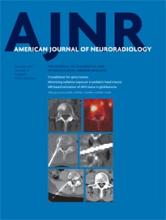Research ArticleADULT BRAIN
Open Access
Differentiating Tumor Progression from Pseudoprogression in Patients with Glioblastomas Using Diffusion Tensor Imaging and Dynamic Susceptibility Contrast MRI
S. Wang, M. Martinez-Lage, Y. Sakai, S. Chawla, S.G. Kim, M. Alonso-Basanta, R.A. Lustig, S. Brem, S. Mohan, R.L. Wolf, A. Desai and H. Poptani
American Journal of Neuroradiology January 2016, 37 (1) 28-36; DOI: https://doi.org/10.3174/ajnr.A4474
S. Wang
aFrom the Departments of Radiology (S.W., Y.S., S.M., R.L.W., H.P.)
M. Martinez-Lage
bDivision of Neuroradiology, Pathology and Laboratory Medicine (M.M.-L.)
Y. Sakai
aFrom the Departments of Radiology (S.W., Y.S., S.M., R.L.W., H.P.)
S. Chawla
fDepartment of Radiology (S.C., S.G.K.), Center for Biomedical Imaging, New York University School of Medicine, New York, New York.
S.G. Kim
fDepartment of Radiology (S.C., S.G.K.), Center for Biomedical Imaging, New York University School of Medicine, New York, New York.
M. Alonso-Basanta
cRadiation Oncology (M.A.-B., R.A.L.,)
R.A. Lustig
cRadiation Oncology (M.A.-B., R.A.L.,)
S. Brem
dNeurosurgery (S.B.)
S. Mohan
aFrom the Departments of Radiology (S.W., Y.S., S.M., R.L.W., H.P.)
R.L. Wolf
aFrom the Departments of Radiology (S.W., Y.S., S.M., R.L.W., H.P.)
A. Desai
eHematology-Oncology (A.D.), Hospital of the University of Pennsylvania, Philadelphia, Pennsylvania
H. Poptani
aFrom the Departments of Radiology (S.W., Y.S., S.M., R.L.W., H.P.)

References
- 1.↵
- Macdonald DR,
- Cascino TL,
- Schold SC Jr., et al
- 2.↵
- Wen PY,
- Macdonald DR,
- Reardon DA, et al
- 3.↵
- 4.↵
- Cha J,
- Kim ST,
- Kim HJ, et al
- 5.↵
- Chu HH,
- Choi SH,
- Ryoo I, et al
- 6.↵
- Lee WJ,
- Choi SH,
- Park CK, et al
- 7.↵
- Suh CH,
- Kim HS,
- Choi YJ, et al
- 8.↵
- Hamstra DA,
- Chenevert TL,
- Moffat BA, et al
- 9.↵
- Hygino da Cruz LC Jr.,
- Rodriguez I,
- Domingues RC, et al
- 10.↵
- 11.↵
- Wang S,
- Kim SJ,
- Poptani H, et al
- 12.↵
- Wang S,
- Kim S,
- Chawla S, et al
- 13.↵
- Wang S,
- Kim S,
- Chawla S, et al
- 14.↵
- Toh CH,
- Castillo M,
- Wong AM, et al
- 15.↵
- 16.↵
- Lacerda S,
- Law M
- 17.↵
- Gasparetto EL,
- Pawlak MA,
- Patel SH, et al
- 18.↵
- Kong DS,
- Kim ST,
- Kim EH, et al
- 19.↵
- Tsien C,
- Galbán CJ,
- Chenevert TL, et al
- 20.↵
- Kim HS,
- Kim JH,
- Kim SH, et al
- 21.↵
- Baek HJ,
- Kim HS,
- Kim N, et al
- 22.↵
- Mangla R,
- Singh G,
- Ziegelitz D, et al
- 23.↵
- Chowdhary S,
- Chamberlain M
- 24.↵Tumor treating fields therapy for recurrent glioblastoma. Manag Care 2012;21:43–44 pmid:23304737
- 25.↵
- 26.↵
- Boxerman JL,
- Prah DE,
- Paulson ES, et al
- 27.↵
- Kim DY,
- Kim HS,
- Goh MJ, et al
- 28.↵
- 29.↵
- Barajas RF Jr.,
- Chang JS,
- Segal MR, et al
- 30.↵
- Pope WB,
- Lai A,
- Mehta R, et al
- 31.↵
- Xu JL,
- Li YL,
- Lian JM, et al
- 32.↵
- 33.↵
In this issue
American Journal of Neuroradiology
Vol. 37, Issue 1
1 Jan 2016
Advertisement
S. Wang, M. Martinez-Lage, Y. Sakai, S. Chawla, S.G. Kim, M. Alonso-Basanta, R.A. Lustig, S. Brem, S. Mohan, R.L. Wolf, A. Desai, H. Poptani
Differentiating Tumor Progression from Pseudoprogression in Patients with Glioblastomas Using Diffusion Tensor Imaging and Dynamic Susceptibility Contrast MRI
American Journal of Neuroradiology Jan 2016, 37 (1) 28-36; DOI: 10.3174/ajnr.A4474
0 Responses
Differentiating Tumor Progression from Pseudoprogression in Patients with Glioblastomas Using Diffusion Tensor Imaging and Dynamic Susceptibility Contrast MRI
S. Wang, M. Martinez-Lage, Y. Sakai, S. Chawla, S.G. Kim, M. Alonso-Basanta, R.A. Lustig, S. Brem, S. Mohan, R.L. Wolf, A. Desai, H. Poptani
American Journal of Neuroradiology Jan 2016, 37 (1) 28-36; DOI: 10.3174/ajnr.A4474
Jump to section
Related Articles
Cited By...
- Centrally Reduced Diffusion Sign for Differentiation between Treatment-Related Lesions and Glioma Progression: A Validation Study
- Diagnostic Performance of PET and Perfusion-Weighted Imaging in Differentiating Tumor Recurrence or Progression from Radiation Necrosis in Posttreatment Gliomas: A Review of Literature
- Identifying Recurrent Malignant Glioma after Treatment Using Amide Proton Transfer-Weighted MR Imaging: A Validation Study with Image-Guided Stereotactic Biopsy
This article has not yet been cited by articles in journals that are participating in Crossref Cited-by Linking.
More in this TOC Section
ADULT BRAIN
Similar Articles
Advertisement











